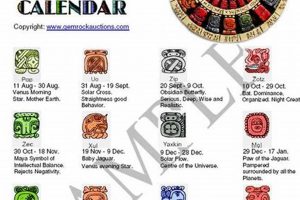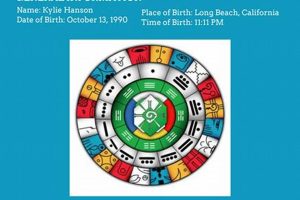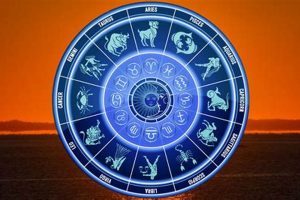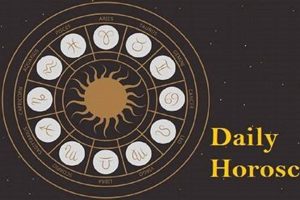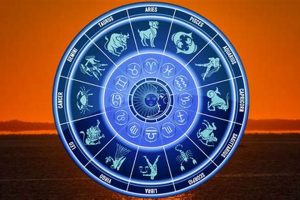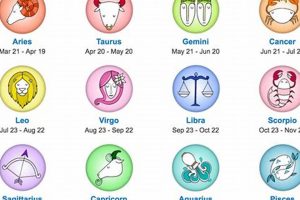This sophisticated system, developed by the ancient Maya civilization, combined intricate astronomical observations with a spiritual understanding of cycles and time. It wasn’t merely a tool for tracking days and seasons, but a complex framework for understanding personality, destiny, and the interconnectedness of all things. For example, a person’s birth date correlated with specific energies and influences believed to shape their character and life path.
This Mesoamerican system offered a profound worldview, providing insights into favorable and challenging periods. By understanding these cyclical patterns, individuals could make informed decisions and navigate life’s transitions with greater awareness. Its historical context reveals a deep connection between the Maya and the cosmos, reflecting their advanced understanding of astronomy and mathematics. The enduring legacy of this system continues to fascinate scholars and spiritual seekers alike.
This exploration will delve further into the specific components, including the Tzolkin, Haab, and Calendar Round, and examine how these interwoven elements provide a comprehensive framework for understanding this ancient system.
Understanding Your Energy Signature
These suggestions offer practical ways to engage with this ancient system for self-reflection and personal growth. Each tip provides a starting point for exploring the intricacies of this complex system.
Tip 1: Identify Your Day Sign and Galactic Tone. Discovering these foundational elements unlocks insights into innate strengths, challenges, and life purpose. Resources like online calculators or specialized texts can assist with this process.
Tip 2: Explore the Meaning of Your Tzolkin Birth Chart. This provides a deeper understanding of the energies influencing one’s personality and destiny. Consulting with an expert can illuminate nuanced interpretations.
Tip 3: Track the Current Day Sign and Galactic Tone. Awareness of the daily energetic influences allows for attuned decision-making and navigation of daily experiences.
Tip 4: Understand the Significance of the Haab Calendar. Connecting with the cycles of nature associated with the Haab deepens understanding of seasonal influences and agricultural rhythms.
Tip 5: Study the Calendar Round. Recognizing the interplay between the Tzolkin and Haab provides a more comprehensive perspective on cyclical patterns and their impact.
Tip 6: Reflect on Personal Experiences Through the Lens of This System. Journaling or meditation can facilitate integration of insights and application to life events.
Tip 7: Consult Reputable Sources. Scholarly research and experienced practitioners offer valuable guidance for accurate interpretation and application of principles.
Integrating these practices offers valuable opportunities for self-discovery, increased awareness, and aligned action. This understanding can facilitate deeper connection with oneself and the cyclical nature of time.
This exploration has provided a foundation for understanding this rich and complex system. Further study and personal reflection can lead to greater insights and a deeper appreciation for the wisdom of this ancient tradition.
1. Tzolkin (Sacred Round)
The Tzolkin, often referred to as the Sacred Round, forms a cornerstone of the ancient Mayan calendrical system. Integral to their cosmology and divination practices, the Tzolkin provides a framework for understanding human nature, destiny, and the cyclical nature of time. Its 260-day cycle, distinct from the solar year, holds a unique position within the broader system, offering insights into energetic influences and their impact on daily life.
- The 20 Day Signs
The Tzolkin comprises 20 unique day signs, each representing distinct energies and characteristics. These glyphs, such as Imix (creation), Ik (wind), and Ahau (sun), symbolize different aspects of life and nature. Each day sign carries specific meanings and influences, offering insights into personality traits, strengths, and challenges.
- The 13 Galactic Tones
Interwoven with the 20 day signs are 13 Galactic Tones, representing different phases of energy. These tones, numbered 1 through 13, influence the expression of each day sign, adding layers of nuance and complexity. For instance, a day sign combined with the tone 1 represents new beginnings, while the tone 13 signifies completion.
- The 260-Day Cycle
The combination of 20 Day Signs and 13 Galactic Tones creates the 260-day Tzolkin cycle. Each day within this cycle holds a unique energetic signature, influencing individual experiences and collective events. This cycle was used for divination, ceremony, and understanding the cyclical nature of life.
- Connection to the Haab and Calendar Round
While functioning independently, the Tzolkin interacts with the 365-day Haab calendar (solar year) to form the Calendar Round, a 52-year cycle. This interplay adds further depth to Mayan timekeeping, providing a more comprehensive understanding of cyclical patterns and their influence on individuals and communities.
Understanding the Tzolkin is essential for grasping the full complexity and depth of the Mayan calendrical system. Its intricate structure and symbolic meanings offer a rich framework for exploring the Mayan worldview and their profound connection to time and cosmology. Further investigation into the interplay between the Tzolkin, the Haab, and the Long Count reveals a sophisticated system designed to track time across various scales, from daily energies to vast historical cycles.
2. Haab (Solar Year)
The Haab, representing the solar year within the Mayan calendrical system, plays a crucial role in understanding agricultural cycles and seasonal shifts. While the Tzolkin focuses on energetic influences, the Haab grounds this system in the observable rhythms of the natural world. Its 365-day cycle provides a practical framework for tracking seasons, planting, and harvesting, demonstrating the Maya’s sophisticated understanding of astronomy and its connection to daily life.
- The 18 Months
The Haab comprises 18 months of 20 days each, totaling 360 days. These months, named after natural phenomena or agricultural activities, reflect the cyclical nature of the seasons and the importance of agriculture within Mayan society. Examples include Pop (mat), Zotz (bat), and Zip (deer).
- The Wayeb’
A five-day period called Wayeb’ follows the 18 months, completing the 365-day solar year. Considered a time of transition and reflection, the Wayeb’ held spiritual significance, representing a period of uncertainty and potential for both positive and negative transformations.
- Agricultural Significance
The Haab served as a vital tool for agricultural planning and management. By tracking the solar year, the Maya could predict seasonal changes, optimize planting and harvesting schedules, and ensure successful crop yields. This practical application demonstrates the integration of astronomical knowledge into everyday life.
- Interplay with the Tzolkin and Calendar Round
The Haab interacts with the 260-day Tzolkin to create the Calendar Round, a 52-year cycle. This interplay of the solar year and the sacred calendar provides a more nuanced understanding of time, weaving together practical considerations with spiritual and divinatory practices.
The Haab, with its focus on the solar year, provides a practical and essential counterpoint to the Tzolkin’s energetic focus. By understanding the interplay between these two systems, one gains a deeper appreciation for the complexity and sophistication of Mayan timekeeping and its connection to both the cosmos and the natural world. Further exploration of the Long Count expands this understanding to encompass vast historical cycles, revealing the Mayan civilization’s remarkable grasp of time and its cyclical nature.
3. Calendar Round
The Calendar Round represents a crucial component within the broader Mayan calendrical system, often referred to as the “Mayan astrology calendar.” It arises from the interaction of two distinct cycles: the 260-day Tzolkin (Sacred Round) and the 365-day Haab (solar year). This cyclical interplay creates a 52-year period before the same combination of Tzolkin and Haab dates repeats, offering a more comprehensive framework for understanding time and destiny within Mayan cosmology.
- The 52-Year Cycle
The Calendar Round functions as a 52-year cycle, representing the time it takes for a specific combination of a Tzolkin day and a Haab day to recur. This period held significant cultural and religious importance for the Maya, marking a complete cycle of time and influencing societal rituals and ceremonies. For example, specific Calendar Round dates were associated with auspicious or inauspicious events, impacting decisions related to agriculture, warfare, and leadership.
- Interplay of Tzolkin and Haab
The Calendar Round’s significance derives from the interplay between the Tzolkin and Haab. The Tzolkin, with its focus on energetic influences and divination, combines with the Haab’s practical tracking of the solar year. This fusion creates a system that integrates both spiritual and practical considerations, providing a more nuanced understanding of time’s impact on individuals and communities. For example, a specific Tzolkin day sign combined with a particular Haab month might have been associated with specific agricultural practices or rituals related to the changing seasons.
- Individual Destiny and Community Events
The Calendar Round influenced interpretations of individual destiny and community events. A person’s birth date within the Calendar Round, combining both Tzolkin and Haab influences, was believed to shape their personality and life path. Similarly, specific Calendar Round dates were associated with historical events and prophecies, influencing collective decisions and actions. This demonstrates the importance of the Calendar Round in shaping both individual and collective experiences.
- Relationship to the Long Count
While the Calendar Round focuses on a 52-year cycle, it also functions within the larger context of the Mayan Long Count, which tracks much longer periods. The interplay between these different calendrical cycles demonstrates the complexity and sophistication of Mayan timekeeping, allowing them to track time across various scales, from daily energies to vast historical epochs. This intricate system reflects a profound understanding of time’s cyclical nature and its influence on all aspects of life.
Understanding the Calendar Round is essential for grasping the intricacies of the “Mayan astrology calendar.” Its 52-year cycle, resulting from the interwoven nature of the Tzolkin and Haab, provides a crucial framework for interpreting individual destinies, community events, and the cyclical patterns of time within the Mayan worldview. This understanding allows for deeper appreciation of the rich tapestry of Mayan cosmology and their sophisticated approach to timekeeping.
4. Long Count
The Long Count, a distinct yet integral component of the Mayan calendrical system, provides a broader chronological framework within which the intricacies of the “Mayan astrology calendar” operate. Unlike the cyclical nature of the Calendar Round, the Long Count is a linear count of days from a mythical creation date, equivalent to August 11, 3114 BCE in the Gregorian calendar. This system allows for the precise placement of events within a vast historical timescale, providing context for understanding the cyclical patterns of the Tzolkin, Haab, and Calendar Round.
The Long Count utilizes a vigesimal (base-20) system, expressing dates as a series of five place values: Baktun, Katun, Tun, Uinal, and Kin. Each unit represents a specific number of days: a Kin is a single day, a Uinal is 20 days, a Tun is 360 days (18 Uinals), a Katun is 7,200 days (20 Tuns), and a Baktun is 144,000 days (20 Katuns). For instance, the much-discussed end of the 13th Baktun on December 21, 2012, marked the completion of a significant cycle within the Long Count, highlighting its importance in understanding Mayan cosmology and prophecies. However, this date did not represent an apocalypse, as often misinterpreted, but rather a transition point within the ongoing linear progression of the Long Count. Instead, it signified the completion of a significant time cycle and the beginning of a new one.
Understanding the Long Count offers crucial context for interpreting the cyclical components of the “Mayan astrology calendar.” While the Tzolkin, Haab, and Calendar Round provide insights into energetic influences and recurring patterns, the Long Count places these cycles within a larger historical narrative. This interplay of linear and cyclical time allows for a more comprehensive understanding of Mayan timekeeping, demonstrating a sophisticated approach to measuring and interpreting time’s influence on individual and collective experiences. The Long Count’s linear progression anchors the cyclical patterns of the “Mayan astrology calendar,” providing a framework for understanding their place within a vast timescale and offering valuable insights into the Mayan worldview. This intricate system underscores the profound importance of time and its multifaceted nature in shaping Mayan cosmology and culture.
5. Day Signs (Energies)
Day Signs represent fundamental components within the framework of the Mayan calendrical system, often referred to as the “Mayan astrology calendar.” These signs, twenty in total, each embody unique energetic qualities and symbolic meanings that influence interpretations of personality, destiny, and daily events. Understanding these Day Signs is crucial for deciphering the complexities of this ancient system and its application to individual and collective experiences.
- Distinct Energies and Characteristics
Each Day Sign embodies distinct energies and characteristics, influencing the interpretation of one’s birth date and the energies associated with specific days within the calendar. Imix, the first Day Sign, represents primordial creation and potential, while Ik symbolizes wind, breath, and communication. These distinct energies offer insights into individual strengths, weaknesses, and life paths. For example, individuals born on an Imix day might be seen as having a strong connection to the creative force, while those born on an Ik day might possess strong communication skills.
- Interaction with Galactic Tones
Day Signs interact with the thirteen Galactic Tones, adding further nuance to their interpretation. The Galactic Tone modifies the expression of the Day Sign’s energy, influencing the specific manifestation of its inherent qualities. For instance, Imix combined with the Galactic Tone 1 signifies the beginning of a creative cycle, while Imix combined with the Galactic Tone 13 represents the completion of such a cycle. This interplay provides a deeper understanding of the dynamic nature of these energies.
- Influence on Personality and Destiny
Within the “Mayan astrology calendar,” Day Signs are believed to influence personality traits, life paths, and individual destinies. One’s birth Day Sign provides insights into inherent strengths, challenges, and karmic lessons. For example, individuals born on a Kan day, associated with the seed and germination, might be seen as possessing innate potential for growth and development, while those born on a Chicchan day, associated with the serpent, might exhibit transformative energies.
- Divination and Ritual Practices
Day Signs played a crucial role in Mayan divination and ritual practices. Priests and diviners used the Day Signs, in conjunction with other calendrical components, to interpret omens, make predictions, and conduct ceremonies. Specific Day Signs were considered auspicious or inauspicious for particular activities, influencing decisions related to agriculture, warfare, and societal events. This highlights the practical application of Day Signs within Mayan culture.
Day Signs form a foundational element of the “Mayan astrology calendar,” offering a framework for understanding individual energies and their interplay within the larger cosmological cycles. By exploring the unique qualities of each Day Sign and their interaction with the Galactic Tones, one gains valuable insights into the rich tapestry of Mayan cosmology and its application to personal and collective experiences. Further exploration of the interplay between Day Signs, the Tzolkin, Haab, and Long Count reveals the depth and complexity of this ancient system and its enduring relevance.
6. Galactic Tones (Influences)
Galactic Tones represent a crucial element within the Mayan calendrical system, often referred to as the “Mayan astrology calendar.” These thirteen tones, numbered 1 through 13, function as energetic influences that modify the expression of the twenty Day Signs. This interaction creates a complex interplay of energies, providing a nuanced understanding of time’s influence on individual destinies and daily experiences. The Galactic Tones are not merely numerical markers; they represent distinct energetic qualities that imbue each day with specific characteristics. This understanding is essential for interpreting the full meaning and significance of dates within the Mayan calendar.
Each Galactic Tone possesses a unique energetic signature, influencing the manifestation of the Day Sign’s inherent qualities. Tone 1, representing Unity and Initiation, imbues the accompanying Day Sign with a sense of new beginnings and fresh starts. In contrast, Tone 13, representing Universalization and Transcendence, signifies completion and the culmination of a cycle. For instance, if the Day Sign Imix, representing creation and potential, is combined with Tone 1, it signifies the initiation of a creative endeavor. However, Imix combined with Tone 13 suggests the completion of a creative project or the culmination of a creative cycle. This interplay allows for a more dynamic and nuanced understanding of the energies at play on any given day.
Understanding Galactic Tones is essential for interpreting the “Mayan astrology calendar” and its application to individual lives. These tones provide a framework for understanding the energetic influences shaping daily experiences and personal destinies. By recognizing the specific Galactic Tone associated with a given day, individuals can gain insights into the prevailing energies and align their actions accordingly. This awareness facilitates a deeper connection with the cyclical nature of time and its impact on personal growth and transformation. The interplay of Galactic Tones and Day Signs provides a rich tapestry of meaning, offering valuable insights into the Mayan worldview and its enduring relevance.
Frequently Asked Questions
This section addresses common inquiries regarding this complex system, offering concise and informative responses to clarify potential misunderstandings and provide deeper insights.
Question 1: Is this system the same as the Aztec calendar?
While both Mesoamerican cultures developed sophisticated calendrical systems, they are distinct. The system in question originated within Mayan civilization and possesses unique features differentiating it from the Aztec calendar, despite some shared astronomical knowledge.
Question 2: How does the “Mayan astrology calendar” differ from Western astrology?
Western astrology primarily focuses on the positions of celestial bodies within the zodiac. The system discussed here emphasizes the interplay of energies represented by the Tzolkin, Haab, and Long Count, offering a different perspective on personality, destiny, and cyclical influences.
Question 3: Did the Mayan calendar predict the end of the world in 2012?
No. December 21, 2012, marked the end of a Baktun cycle within the Long Count. This date signified a transition or completion of a significant time period, not an apocalyptic event. Mayan cosmology emphasizes cyclical renewal, not a catastrophic end.
Question 4: How can one determine their Mayan day sign and Galactic tone?
Online calculators and specialized resources offer methods for determining these based on one’s Gregorian birth date. Consulting with experts in this field can provide further personalized insights.
Question 5: Is this system still relevant today?
Many individuals continue to find value in the insights provided by this system. Its enduring relevance lies in its potential for self-discovery, understanding cyclical patterns, and connecting with a rich cultural heritage. Its continued study offers opportunities for personal growth and deeper understanding of time’s influence.
Question 6: What resources are available for further learning?
Scholarly publications, reputable websites, and experienced practitioners offer resources for further exploration. Engaging with these resources allows for deeper understanding and accurate interpretation of this complex system.
Understanding the nuances of this system requires diligent research and a willingness to engage with its complex structure. Consulting reputable sources and seeking guidance from experienced practitioners are crucial for accurate interpretation and application of its principles.
Further sections will explore the practical applications of this system for self-discovery and personal growth.
Conclusion
This exploration of the Mayan astrology calendar has revealed a sophisticated system of timekeeping interwoven with cosmology and spirituality. From the intricate interplay of the Tzolkin, Haab, and Calendar Round to the vast historical scope of the Long Count, this system offers a unique perspective on cyclical time, individual destiny, and the interconnectedness of all things. The examination of Day Signs and Galactic Tones illuminated the dynamic energies influencing daily experiences and personal characteristics. This intricate framework, developed by the ancient Maya civilization, reflects a profound understanding of astronomical cycles and their influence on human life.
The Mayan astrology calendar stands as a testament to the ingenuity and deep spiritual understanding of the Maya. Its enduring legacy invites continued exploration and contemplation of its intricate structure and enduring wisdom. Further research and personal reflection offer opportunities to deepen understanding of this complex system and its potential to provide insights into the cyclical nature of time and its profound influence on human experience. The intricate knowledge embedded within this system offers valuable perspectives on the interconnectedness of time, cosmology, and human existence.


